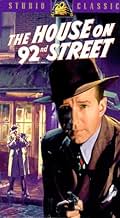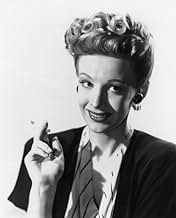VALUTAZIONE IMDb
6,6/10
3376
LA TUA VALUTAZIONE
Bill Dietrich diventa un doppiogiochista per l'FBI in un giro di spie naziste.Bill Dietrich diventa un doppiogiochista per l'FBI in un giro di spie naziste.Bill Dietrich diventa un doppiogiochista per l'FBI in un giro di spie naziste.
- Vincitore di 1 Oscar
- 2 vittorie totali
William Post Jr.
- Walker
- (as William Post)
William Adams
- Customs Officer
- (non citato nei titoli originali)
Frieda Altman
- Saboteur
- (non citato nei titoli originali)
William Beach
- Saboteur
- (non citato nei titoli originali)
Carl Benson
- German Spy Trainee
- (non citato nei titoli originali)
Hamilton Benz
- Saboteur
- (non citato nei titoli originali)
Trama
Lo sapevi?
- QuizThe movie deals with the theft by German spies of the fictional "Process 97", a secret formula which, the narrator tells us, "was crucial to the development of the atomic bomb." The movie was released on September 10, 1945, only a month after the atomic bombs had been dropped on Japan, and barely a week after Japan's formal surrender. While making the film, the actors and Director Henry Hathaway did not know that the atomic bomb existed, nor that it would be incorporated as a story element in the movie. (None of the actors in the film mentioned the atomic bomb.) However, co-Director and Producer Louis De Rochemont (who produced the "March of Time" newsreel films) and Narrator Reed Hadley were involved in producing government films on the development of the atomic bomb. (Hadley was present at the final test of the bomb in Los Alamos, New Mexico, in July, 1945.) After the bomb was dropped on Hiroshima, Hadley and Screenwriter John Monks, Jr. hastily wrote some additional voice-over narration linking "Process 97" to the atomic bomb, and Rochemont inserted it into the picture in time for the film's quick release.
- BlooperThe description of a one-way mirror as an "X-ray" mirror at the beginning is nonsense. A one-way mirror is in fact merely a partially-silvered mirror. It becomes "one-way" by virtue of different lighting on either side - one side dimly lit, the other brightly lit. From the side that's brightly lit, it appears to be a normal mirror because the reflection washes out any light coming through from the dim side. But from within the dim side, everything on the bright side is readily visible because the light coming through predominates over the reflection seen from the dim side.
- Citazioni
Agent George A. Briggs: We know all about you, Roper. We've traced you to the day you were born. We even know the approximate day you will die.
- Curiosità sui creditiOpening credits are shown as someone flipping through the pages of a file.
- ConnessioniReferenced in 23 passi dal delitto (1956)
- Colonne sonoreTra-La-La-La
(uncredited)
Music by Harry Warren
Played as background music at the talent agent's office
Recensione in evidenza
The House on 92nd Street (1945)
Henry Hathaway has directed some great film noirs (Kiss of Death is indisputably great), but he also didn't mind the dull assignment here and there, as in the competent Call Northside 777 and this one, both revealing American crime detection in action. Yes, this is actually well made, but it has a documentary feel that leaves it in a straitjacket as good crime drama. It's strong stuff, and filled with significance, real Nazi activities on U.S. soil leading to the a-bomb. But you'll see, as soon as the familiar narrator starts to explain the events, that it's a formulaic approach.
To some extent, you can't really watch this without noticing it feels, from the next century (2010 as I write) like propaganda. Not that it isn't honest, it just is filled with uncritical pride. The FBI in particular comes across as flawless and brilliant, and I'm sure it often was, but not quite without complications, nuances, and personal quirks that make the best fiction films take off. This one was made just as World War II was over in Europe, and there was nothing but patriotism in the air, naturally.
I actually like Leo G. Carroll a lot, and he holds up his scenes well, and Swedish actress Signe Hasso is a surprise, strong and sharp (wait until she takes her wig off and transforms in ten seconds). Much of the movie, especially after the first half hour with all its narration and actual documentary footage, has the feel of any well constructed drama and those are the parts, for me, to hook into. Besides, there is a quality here that's really pretty fun--a glimpse into the attitude of 1945 America that isn't the usual brazen, lonely, taut film noir response. Fiction makes for better movie-going, in this case, but here is a watchable quasi-documentary that holds up pretty well, off and on, if you keep expectations in check.
Henry Hathaway has directed some great film noirs (Kiss of Death is indisputably great), but he also didn't mind the dull assignment here and there, as in the competent Call Northside 777 and this one, both revealing American crime detection in action. Yes, this is actually well made, but it has a documentary feel that leaves it in a straitjacket as good crime drama. It's strong stuff, and filled with significance, real Nazi activities on U.S. soil leading to the a-bomb. But you'll see, as soon as the familiar narrator starts to explain the events, that it's a formulaic approach.
To some extent, you can't really watch this without noticing it feels, from the next century (2010 as I write) like propaganda. Not that it isn't honest, it just is filled with uncritical pride. The FBI in particular comes across as flawless and brilliant, and I'm sure it often was, but not quite without complications, nuances, and personal quirks that make the best fiction films take off. This one was made just as World War II was over in Europe, and there was nothing but patriotism in the air, naturally.
I actually like Leo G. Carroll a lot, and he holds up his scenes well, and Swedish actress Signe Hasso is a surprise, strong and sharp (wait until she takes her wig off and transforms in ten seconds). Much of the movie, especially after the first half hour with all its narration and actual documentary footage, has the feel of any well constructed drama and those are the parts, for me, to hook into. Besides, there is a quality here that's really pretty fun--a glimpse into the attitude of 1945 America that isn't the usual brazen, lonely, taut film noir response. Fiction makes for better movie-going, in this case, but here is a watchable quasi-documentary that holds up pretty well, off and on, if you keep expectations in check.
- secondtake
- 17 mar 2010
- Permalink
I più visti
Accedi per valutare e creare un elenco di titoli salvati per ottenere consigli personalizzati
- How long is The House on 92nd Street?Powered by Alexa
Dettagli
- Data di uscita
- Paese di origine
- Lingue
- Celebre anche come
- The House on 92nd Street
- Luoghi delle riprese
- Amburgo, Germania(second unit)
- Azienda produttrice
- Vedi altri crediti dell’azienda su IMDbPro
Botteghino
- Lordo Stati Uniti e Canada
- 2.500.000 USD
- Tempo di esecuzione1 ora 28 minuti
- Colore
- Proporzioni
- 1.37 : 1
Contribuisci a questa pagina
Suggerisci una modifica o aggiungi i contenuti mancanti

Divario superiore
By what name was La casa della 92ª strada (1945) officially released in India in English?
Rispondi





























